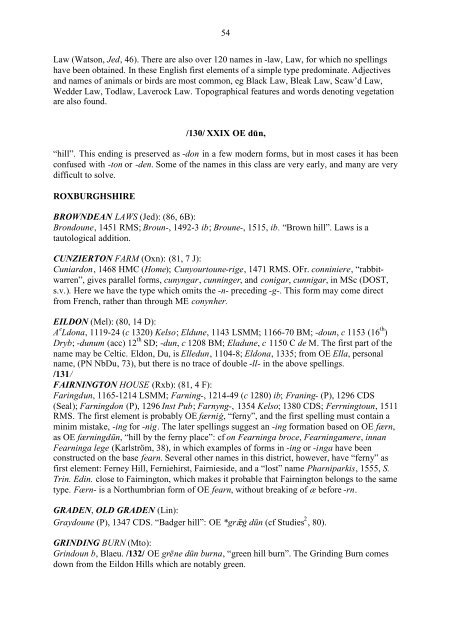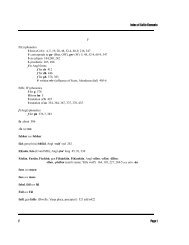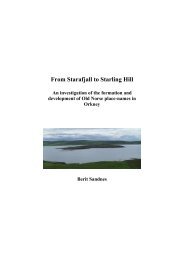May Williamson: The Non-Celtic Place-Names of the Scottish Border ...
May Williamson: The Non-Celtic Place-Names of the Scottish Border ...
May Williamson: The Non-Celtic Place-Names of the Scottish Border ...
Create successful ePaper yourself
Turn your PDF publications into a flip-book with our unique Google optimized e-Paper software.
54<br />
Law (Watson, Jed, 46). <strong>The</strong>re are also over 120 names in -law, Law, for which no spellings<br />
have been obtained. In <strong>the</strong>se English first elements <strong>of</strong> a simple type predominate. Adjectives<br />
and names <strong>of</strong> animals or birds are most common, eg Black Law, Bleak Law, Scaw’d Law,<br />
Wedder Law, Todlaw, Laverock Law. Topographical features and words denoting vegetation<br />
are also found.<br />
/130/ XXIX OE dūn,<br />
“hill”. This ending is preserved as -don in a few modern forms, but in most cases it has been<br />
confused with -ton or -den. Some <strong>of</strong> <strong>the</strong> names in this class are very early, and many are very<br />
difficult to solve.<br />
ROXBURGHSHIRE<br />
BROWNDEAN LAWS (Jed): (86, 6B):<br />
Brondoune, 1451 RMS; Broun-, 1492-3 ib; Broune-, 1515, ib. “Brown hill”. Laws is a<br />
tautological addition.<br />
CUNZIERTON FARM (Oxn): (81, 7 J):<br />
Cuniardon, 1468 HMC (Home); Cunyourtoune-rige, 1471 RMS. OFr. conniniere, “rabbitwarren”,<br />
gives parallel forms, cunyngar, cunninger, and conigar, cunnigar, in MSc (DOST,<br />
s.v.). Here we have <strong>the</strong> type which omits <strong>the</strong> -n- preceding -g-. This form may come direct<br />
from French, ra<strong>the</strong>r than through ME conynher.<br />
EILDON (Mel): (80, 14 D):<br />
A e Ldona, 1119-24 (c 1320) Kelso; Eldune, 1143 LSMM; 1166-70 BM; -doun, c 1153 (16 th )<br />
Dryb; -dunum (acc) 12 th SD; -dun, c 1208 BM; Eladune, c 1150 C de M. <strong>The</strong> first part <strong>of</strong> <strong>the</strong><br />
name may be <strong>Celtic</strong>. Eldon, Du, is Elledun, 1104-8; Eldona, 1335; from OE Ella, personal<br />
name, (PN NbDu, 73), but <strong>the</strong>re is no trace <strong>of</strong> double -ll- in <strong>the</strong> above spellings.<br />
/131/<br />
FAIRNINGTON HOUSE (Rxb): (81, 4 F):<br />
Faringdun, 1165-1214 LSMM; Farning-, 1214-49 (c 1280) ib; Franing- (P), 1296 CDS<br />
(Seal); Farningdon (P), 1296 Inst Pub; Farnyng-, 1354 Kelso; 1380 CDS; Ferrningtoun, 1511<br />
RMS. <strong>The</strong> first element is probably OE færniġ, “ferny”, and <strong>the</strong> first spelling must contain a<br />
minim mistake, -ing for -nig. <strong>The</strong> later spellings suggest an -ing formation based on OE færn,<br />
as OE færningdūn, “hill by <strong>the</strong> ferny place”: cf on Fearninga broce, Fearningamere, innan<br />
Fearninga lege (Karlström, 38), in which examples <strong>of</strong> forms in -ing or -inga have been<br />
constructed on <strong>the</strong> base fearn. Several o<strong>the</strong>r names in this district, however, have “ferny” as<br />
first element: Ferney Hill, Ferniehirst, Fairnieside, and a “lost” name Pharniparkis, 1555, S.<br />
Trin. Edin. close to Fairnington, which makes it probable that Fairnington belongs to <strong>the</strong> same<br />
type. Færn- is a Northumbrian form <strong>of</strong> OE fearn, without breaking <strong>of</strong> æ before -rn.<br />
GRADEN, OLD GRADEN (Lin):<br />
Graydoune (P), 1347 CDS. “Badger hill”: OE *grġdūn (cf Studies 2 , 80).<br />
GRINDING BURN (Mto):<br />
Grindoun b, Blaeu. /132/ OE grēne dūn burna, “green hill burn”. <strong>The</strong> Grinding Burn comes<br />
down from <strong>the</strong> Eildon Hills which are notably green.




